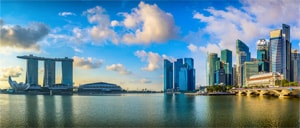A BATTLE, NOT A WAR
By Arthur Clennam and Al Emid
Asian central banks’ reactions to global monetary intervention will be muted. But weakening currencies are problematic for local business.

As in physical conflict, no two wars are the same. While defense of currencies is still ongoing in Latin America and Asia’s emerging markets, the action by central banks underscores a diversity of motives.Analysts disagree whether emerging Asian central banks will respond with more aggressive intervention. The goal, of course, would be to protect exports, particularly at time when demand for imports is weak, especially in Europe.
“Not all policymakers are looking for the same thing,” said HSBC emerging markets analyst Paul Mackel. “Many in the Latin American region are steadily countering local currency strength,” he says, but adds that “each case in Asia is different, and to lump the region together would likely lead to erroneous conclusions.”
The last currency war—in which central banks intervene to prevent their currencies from appreciating—occurred following the quantitative easing initiated by the US Fed in 2010. QEIII has seen a milder reaction and a colder war. At the end of October, most Asian currencies had appreciated against the US dollar from the beginning of the month, led by a 1.9% rise in the South Korean won, driven largely on demand from offshore funds and exporters. The Philippine peso rose 1.2% against the greenback, a response to the upgrading of the nation’s sovereign debt by Moody’s Investors Service. The Singapore dollar rose 0.5% despite intervention by its central bank. The Thai baht was also up 0.5% during the month, and the Chinese renminbi was up 0.7%.
The response in Latin America to the US QEIII has been more consistent. Brazil’s government has intervened several times. Similarly, Peru and Colombia have intervened to stop their currency from rising against the dollar. Chile has seen its currency appreciate against the dollar 8% since the beginning of 2012. Central bank president Rodrigo Vergara said on October 25 that Chile reserved the right to intervene, but “it’s not the right moment for now.”
 |
|
Ostenfeldt, Thome Ship Management: The weakness of the US dollar against the Singapore dollar will not change for some time |
Will Asian policymakers look for more insurance via weaker currencies? The balance of evidence “for such a preference is not compelling,” Mackel says. He points out that Asia ex-China’s trade deficit mostly reflects strong local oil demand. Having a weaker currency would be unlikely to narrow the oil deficit, largely because many countries—India and Indonesia, to name two—in emerging Asia provide subsidies for local buyers of petroleum products. At the same time, says Mackel, weakening currencies will make economies susceptible to inflation, as imports (outside of oil) become more expensive. Another danger to local economies is that as currencies weaken, onshore businesses tend to hold more foreign currencies, posing liquidity dangers for local economies.
In addition, a problem emerges for companies that run businesses with a large amount of US dollar receivables, but payables in local currencies. This makes global businesses based in Singapore, such as logistics and shipping firms, susceptible. “Our response is that we do not want to be bigger in Singapore,” says Carsten Ostenfeldt, chief executive of Singapore-based Thome Ship Management. He believes that the long-standing weakness of the US dollar against the Singapore dollar will not reverse itself significantly for some time. “It’s going to take a while,” he says. That said, Ostenfeldt is hardly thinking of leaving Singapore, which offers other benefits, including tax breaks for maritime companies.
On both the corporate and policy level in Asia’s robust economies, calls for a “warlike” reaction to QEIII are undermined by the stubbornly slow but palpable US recovery, which inched forward through the autumn. Certainly, Asian central bankers will keep on their guard, but this war looks more like a skirmish than a slugfest.
—Arthur Clennam
COMPETITION RESHAPES ASIAN BANKING
The competition between regional banks is increasing, as they expand into new markets, seeking growth. At the same time, global financial institutions are selectively pulling back from the field without leaving it altogether.
The competition offers substantial rewards, according to Andrew Sleeman, research analyst at Franklin Mutual Advisers. “Asian balance sheets are in good shape,” he says, referring to individual and corporate balance sheets.
Some regional banks have already acquired super-regional status. In a report, Singapore’s IDC Financial Insights defines super-regionals as “homegrown banks building significant regionwide platforms.”
“You have to make a differentiation between domestic players and domestic players that have regional ambitions,” says Michael Araneta, IDC Financial’s research director. Market saturation at home drives them abroad. Australia, Malaysia and Singapore have become overbanked in recent years, and so some initiatives amount to jockeying for future markets.
Mergers and acquisitions were a hallmark of growth for many of the super-regionals until recently. ANZ, out of Australia, led the charge, buying stakes of various sizes in Panin in Indonesia, AmBank in Malaysia, Royal Bank in Cambodia, Tianjin City Commercial Bank in China and Shanghai Rural Commercial Bank. These moves reflect ANZ’s stated goal of deriving 25% to 35% of revenues from outside Australia and New Zealand by 2017.
Singapore’s OCBC Bank has become heavily entrenched in Malaysia and currently has eight branches and eight sub-branches in Mainland China and a stake in China’s Ningbo Bank and Vietnam’s VP Bank. Another Singapore-based firm, DBS bank, has built a branch network across China, Taiwan and Hong Kong that accounts for about 25% of its revenue and has a target of deriving 60% of revenue from outside Singapore by 2015.
DECLINE OF THE GLOBALS
In one trend that has indirectly given the super-regionals additional room to expand, some global banks have rationalized their operations in the region as a result of the financial crisis. HSBC has exited from retail banking in Thailand, Pakistan and Japan and is looking for a buyer for its retail banking businesses in South Korea and Pakistan. It has also sold several of its insurance businesses in the region.
ING is selling its insurance units in Hong Kong, Macau and Thailand to Hong Kong’s Pacific Century Group. That follows divestments in Asia and elsewhere, including the sale of its general insurance unit and retail banking and wealth management businesses in Thailand. And in 2009 the Royal Bank of Scotland sold its Asian banking business to ANZ.
Also spurring on the super-regionals is the attraction of underbanked markets in countries such as Cambodia, China, Indonesia, the Philippines and Vietnam. The Commonwealth Bank of Australia, DBS, ANZ, and OCBC have moved into these markets as their governments have relaxed restrictions on foreign financial institutions.
“Indonesia is the market which seems to be sort of the golden chalice at the moment,” Sleeman explains. It has a large population and high GDP growth rates per capita coupled with a low ratio of loans to GDP. One positive aspect of the growth of regional banks in Asia is that there tends to be little correlation between the banks. Chinese banks, for example, typically do much of their lending to Chinese state-owned enterprises, not to banks and companies in other countries. “They make most of their loans to state-owned companies, who then go and buy stuff,” he explains.
Moreover, with the exception of ANZ, these banks tend to work on a relationship basis, meaning that they lend to companies and individuals with whom they have long-standing relationships. Their expansion tends to follow the activities of their customers. For example, South Korean banks do much of their lending to the chaebols or family conglomerates responsible for much of the country’s exports and gross domestic product, such as Samsung Group, Hyundai Motor and the LG Group.
Still, the long-term health of the super-regional banks could be affected if a continued slowdown in China hits regional trade, and thus trade finance activities.
—Al Emid
 EMERGING MARKETS REGIONAL REVIEW: ASIA
EMERGING MARKETS REGIONAL REVIEW: ASIA


